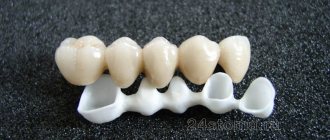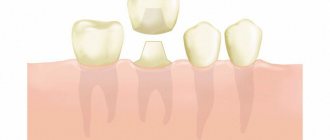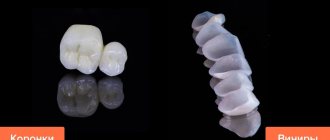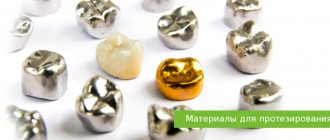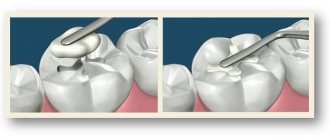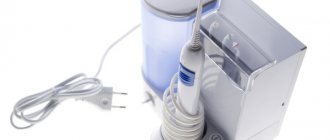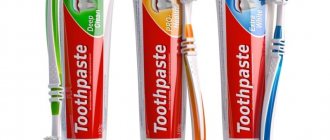30.11.2019
Tooth loss can be associated with oral diseases or old age. Sports and other injuries often lead to their loss. Whatever the reason, modern dentistry has in its arsenal enough options for individual solutions in the form of prosthetics using various materials.
Two types of dental structures are used in prosthetics
- REMOVABLE
- FIXED
Materials for making a prosthesis can be:
- Plastic – for short-term use on chewing teeth or on the front teeth, where the mechanical impact is several times less;
- Metal – considered stronger and more durable. Not suitable for people with allergies to metal. Manufactured in a one-piece version and stamped by soldering;
- Ceramics are well suited for prosthetics in those areas that are visible to others, since during manufacturing the natural color of existing teeth can be easily matched. The appearance completely reproduces the natural dentition;
- Mixed composite materials - metal-ceramics, metal-plastic.
Metal-ceramics and metal-plastic are a combined material; each of them has positive and negative characteristics. Which artificial teeth, made of metal-ceramics or metal-plastic, is best to choose? To answer this question, it is worth studying each material in detail.
Main features of metal-ceramic prostheses
This type of prosthesis is a type of solid cast structure; it consists of a metal base (frame) with ceramic lining. It is created from special alloys (zirconium dioxide, cobalt/chrome or nickel/chrome) designed specifically for dental needs. Sometimes alloys containing precious metals (gold, silver, palladium) are used to make the base. Depending on what metals the metal ceramics contain, the price of prostheses may vary.
Tooth crowns: which ones are better in price?
The cost of crowns consists of materials, technologies and equipment used, as well as the qualifications of the doctor and the level of the clinic where the treatment is performed.
Types of crowns for teeth and which ones are better in terms of cost
| Type of crown | Price |
| Metal crown | 3,000 rubles |
| Metal-ceramic crown | 7,000 rubles. Metal-ceramics with shoulder mass - on average from 12,000 to 14,000 rubles, but may cost more (depending on the alloy and manufacturing technology) |
| Gold or platinum crown | 15,000 rubles. The upper threshold can reach 40,000 - 50,000 rubles |
| Ceramic crown | 15,000 rubles for standard crowns. Using Empress technology - on average 20,000 - 23,000 rubles |
| Zirconium dioxide crowns | 25,000 rubles |
You can view all prices for dental crowns here.
Pros and cons of metal-ceramic dental prosthetics
Has the following advantages:
- aesthetics - the design is absolutely no different in appearance from living teeth, harmonizing with them in shape and color (an extensive palette of shades of ceramic coating);
- biological compatibility – indifference to oral tissues, practically does not cause allergies (there is always a percentage of side effects, depending on individual sensitivity);
- functionality – teeth made of metal-ceramics function on a par with natural ones and do not create differences or discomfort;
- durability - durable, withstands chewing loads well, distributes them evenly, which minimizes the risk of chips, cracks, and deformation. Service life is about 10 years or more;
- hygiene – not susceptible to the influence of bacteria and microorganisms;
- color fastness - not colored by any food coloring, which eliminates restrictions on food and drinks;
- tooth protection – fits tightly to the surface, preventing further destruction.
Flaws:
- depulping and turning - installation requires removal of dental nerves and partial removal of hard tissues;
- It is possible for the contacting natural teeth to wear down because they are softer.
The main places for installing such dentures are the lateral areas, which bear the chewing load. On the front teeth, structures based on zirconium dioxide are used, which does not shine through the ceramics. Crowns are placed on a partially destroyed tooth. If only the root remains, then a metal-ceramic is installed on the pin, and if one or more teeth are completely missing, a bridge is installed.
Which ones are better to choose?
Clinics offer many options for crowns. One of the differences between them is the material used. It is on this parameter that the quality, cost, indications for the use of a particular crown and, of course, aesthetics largely depend. Another very important nuance that also affects the quality parameters is the manufacturing technology of the product.
Types of crowns
- Metal crowns.
They are considered hopelessly outdated. They can be made from various alloys (cobalt-chromium, nickel-chromium). Among the disadvantages are the not very aesthetic appearance, the risk of an allergic reaction to the metal. - Crowns made of precious metals.
As a rule, these are solid prostheses made of gold-platinum alloy. They allow you to achieve the necessary strength and maintain biocompatibility. However, crowns are not made entirely from this alloy. It is used as a frame for metal-ceramic crowns and is covered with ceramics on top. - Metal-ceramic crowns.
The most common products that consist of a metal frame and ceramic cladding. First, the frame is cast, then a layer of ceramic is applied, which can be manufactured using computer modeling. - All-ceramic crowns.
Metal-free ceramic crowns. Due to its biological inertness, this material is considered one of the safest for soft tissues. Manufactured using firing technology (on a refractory model or platinum foil); ceramic pressing method (surface painting technique or layering technique); on a milling machine using CAD/CAM computer modeling. - Zirconium dioxide crowns.
They are manufactured using computer modeling using special milling equipment. There are two types of zirconium dioxide crowns: monolithic (entirely made of zirconium dioxide without veneering) and combined (porcelain mass is applied to a zirconium dioxide frame). The presence of a frame allows you to hide darkened teeth, as well as existing metal inlays and pins. This gives the prosthesis more aesthetics.
There are also temporary crowns that are placed while the permanent structure is being manufactured, but we cannot talk about them as a full-fledged orthopedic structure.
Each of these types of crowns has variations within its category (type of alloy, material features, production method). The overall quality indicator consists of many nuances that must be taken into account when choosing a product. Below is a table with the main parameters that determine the quality of the crown. Two plus signs or two minus signs indicate a characteristic feature of the crown in a particular indicator.
Quality table
| Product | Strength | Aesthetics | Durability |
| Metal crown | + | – – | +/– |
| Golden crown | + | – | + |
| Metal-ceramic crown | +/– | +/– | +/– |
| Ceramic crown | + (depending on the type of crown) | ++ | + |
| Zirconium dioxide crown | + | + | ++ |
All types of crowns are capable of restoring the functionality of a tooth, but the appropriateness of choosing one or another product largely depends on the specific clinical case.
Metal-plastic dental crowns
The design is similar to metal-ceramic, but covered with plastic. Their purpose is to create a temporary prosthesis.
The benefits include:
- low cost and speed of production;
- ease of repair in case of breakdown;
- less trauma during installation.
Flaws:
- fragility - up to 3 years;
- the softness of the coating, which over time causes deformation and chipping;
- the porosity of the plastic leads to the absorption of dyes, the prosthesis begins to differ in color, this is not aesthetically pleasing;
- loose fit - causes an unpleasant odor in the mouth due to stuck pieces of food.
When it cannot be installed
Unfortunately, in medicine there is no universal treatment method that would suit everyone without exception. Before placing a crown on a tooth, discuss possible contraindications with your doctor:
- the presence of inflammatory processes in the acute stage (common stomatitis, periodontitis, pulpitis and other diseases, for example, periodontal disease and gingivitis);
- malocclusion.
Varieties
The difference in tissues from which dental crowns are created depends on the type of teeth:
- More attention is paid to the front teeth; it is important for patients to obtain an aesthetically pleasing result with a natural color, since they are the focus of attention when communicating;
- on chewing teeth, it is possible to use cheap and simple materials, especially when located far away; however, the structure must be durable to bear the chewing load.
Additional information: children of the nineties remember the golden bridges that adults flaunted, including on the visible row - a symbol of prosperity and wealth. Professional dentistry has long moved away from “jewelry” in the production of prosthetics, however, according to reviews on the Internet, this method of prosthetics is still found in settlements remote from the center.
Metal
Metal is suitable for crowns on chewing teeth because of its strength to withstand the daily stress of eating food. An older and less applicable method of tooth replacement.
Titanium construction is a hypoallergenic installation that causes a lower percentage of rejection.
The lack of visual aesthetics reduces the popularity of such systems, however, customers are attracted by the low cost and durability.
Metal ceramics
A metal-ceramic tooth crown is a frame made of precious metals (gold, platinum, palladium) and an outer ceramic “case” to give a natural look to the new denture.
Porcelain veneer is selected in accordance with the color of the dentition, so as not to differ from its neighbors and at the same time be highly durable and wearable for up to 15 years.
A popular type of restoration that provides a guaranteed result at a relatively low cost.
Advantages:
- durability;
- suitable for 99% of those who seek help;
- safety due to hypoallergenic raw materials.
Only ceramics
A ceramic crown is suitable for fixing to a tooth in the smile area - a place where a person does not make chewing movements, since ceramics are strong, but not strong enough for constant pressure.
The structure on the metal frame “shines through” the metal, thereby increasing the yellowness and reducing the beauty of the altered tooth. When installed without a metal structure, there will be nothing to “shine through”.
Metal-based plastic
This replacement of a lost tooth is suitable only for temporary use, for example, during the production of a permanent crown, as it has a number of obvious disadvantages:
- visibility of metal through the plastic “cap”;
- loss of original white color;
- fragility under constant exposure.
However, an affordable price and a shelf life of one to three years ensure a percentage of demand.
This type of material also includes a completely plastic crown, which is also intended for temporary wear. The advantages are similar: low costs, easier installation.
Zirconium
The most expensive orthopedic structures are made from zirconium dioxide or oxide, which has a bright white color and is as strong as devices with a metal base.
Due to its unique combination of properties, it is suitable for visible teeth as well as for the back row. In addition, they are not translucent and completely hypoallergenic.
Thus, to understand which dental crowns are better, it is necessary to understand the patient’s goals, financial capabilities and the location of the destroyed tooth.
Glass ceramics Emax
The desire for an aesthetically pleasing appearance of teeth pushes specialists to search for new materials for crowns. The Ivoclar Vivadent company from Liechtenstein offers an alternative to the usual raw materials - glass ceramics - an option for metal-free prosthetics (including veneers and bridges up to three units long).
The structure is 70% lithium disilicate, the advantages of which are:
- maximum resemblance to the enamel of real teeth;
- increased light transmittance (glass matrix);
- matching the color and texture of neighboring teeth, which makes it invisible in the dentition;
- wide selection of tones and shades.
In terms of its properties, glass ceramics outperforms its counterparts made of zirconium dioxide, therefore it is most applicable to the visible part of the jaw.
Despite the delicate level of design, it is highly durable due to its structure (pressed E-max Press or monolithic E-max Cad ceramics). Zirconium and metal ceramics tend to wear out over time, which inevitably leads to chips in more than 6% of patients.
E-max press is produced by pressing at high pressure and temperature.
Glass ceramics are suitable for:
- installation on single teeth, regardless of location (withstands chewing load);
- bridges up to three units even for the front teeth;
- installation of veneers and lumineers;
- high transparency enamel.
Contraindications:
- not suitable for distant chewing teeth (the last support is attached to a maximum of the fifth tooth);
- prohibited in the presence of bruxism;
- This is not possible if the tooth is of a dark color.
In addition, if more than 3 teeth are missing, installation of Emax is impossible, since the load on the chewing teeth will be distributed incorrectly (mainly on the preserved natural ones), which will lead to the destruction of the crowns, malocclusion and the location of the teeth.
Metal-free glass ceramics will cost the user much more than zirconium and metal-ceramic analogues, this is due to the unique design properties that make it possible to achieve one hundred percent coincidence and naturalness, therefore it is suitable for connoisseurs of real aesthetics.
What does the process involve?
After the patient chooses the material for the future denture, he will have to go through a preparatory stage, which includes:
- Consultation with an orthopedic dentist - during which they will conduct a detailed examination of the oral cavity for the presence of carious disease that prevents further work; at the first appointment, they will draw up a treatment plan and determine how much a crown per tooth costs;
Note! At the beginning, the doctor must include x-rays to determine the “scale of the disaster” and tissue destruction for an accurate diagnosis and determine the possibility of installing a prosthesis. Our clinic offers all types of x-ray examinations: targeted x-ray, panoramic dental x-ray, computed tomography.
- Sanitation - treatment of caries if present, getting rid of stomatitis and bruxism; in addition, dentists recommend undergoing hygienic treatment to avoid the possibility of introducing bacteria;
- If necessary, the tooth canals are cleaned;
- Tooth grinding - removal of a layer of the tooth (from 1.3 to 2 mm depending on the tissue of the structure), is carried out under local anesthesia, painlessly and takes about an hour; This procedure is also possible under a microscope, in this case fractions of a millimeter of tooth tissue are removed and accuracy increases;
- Taking impressions - for this purpose, an impression mass is used to make an impression of both jaws, or a scan of all teeth;
- Manufacturing of crowns - in a dental laboratory in accordance with the impressions obtained;
- The use of a temporary crown made of plastic is carried out especially on prominent teeth, so that the patient feels confident while the final crown is being made.
Next, after the crowns pass the control of the dental technician, the main stage occurs. During this period, the patient needs to listen to the sensations and in case of even minor inconvenience caused by the crown, inform the attending physician about this, at this stage corrections can be made.
Preparation for prosthetics and its stages
Whether it is metal-ceramics or metal-plastic, the general technology of prosthetics with these materials is practically the same.
Preparatory activities include
professional visual examination and control x-ray to ensure there are no foci of inflammation. If there are any, they must be eliminated therapeutically;- if there are previously sealed canals, monitor their condition; if necessary, damaged seals are removed and new ones are installed;
- tooth depulpation procedure - nerves are removed followed by canal filling. When installing a prosthesis on a front tooth, this is mandatory; in the case of a multi-rooted tooth, the decision is made by the dentist based on the individual characteristics of the patient and the condition of the tooth. This need is caused by the high probability of pulp destruction with accompanying unpleasant symptoms, which will entail removal of the prosthesis and additional treatment. Therefore, this moment is extremely important;
- in case of carious tooth damage, therapeutic treatment is carried out until the process is completely eliminated;
- if the tooth is destroyed by less than 50%, then a pin is installed in the root canal. Next, the tooth crown is restored using filling materials;
- complete or critical destruction of the coronal part of the tooth requires the installation of a stump inlay.
Stages of prosthetics
- circular grinding of the tooth to the thickness of the walls of the crown, thus forming a stump;
- the color of the future prosthesis is selected using a special scale;
- a measuring impression is taken, on the basis of which the dental technician creates a metal-ceramic or metal-plastic prosthesis;
- the patient is temporarily (7-10 days) fitted with a special plastic crown. This is done to protect the ground tooth and eliminate the patient’s psychological discomfort, because a ground tooth looks unaesthetic;
- direct installation of the finished prosthesis, including fitting and, if necessary, adjustment.
Which removable dentures are better?
It is impossible to choose one option that will be better for all cases without exception. The preferred options should be chosen based on the needs and the current clinical picture. Most often, patients are interested in which removable dentures are better:
- with complete edentia;
- with partial edentia;
- for the upper jaw;
- for the lower jaw.
By studying the opinions of orthopedic dentists outlined below, you are guaranteed to be able to make the right choice in favor of the removable denture that will be best for you.
With complete edentia
The problem of complete absence of teeth is solved by two types of removable dentures:
- On implants
. They perfectly restore chewing function and provide reliable fixation. They guarantee a uniform load, which is very important to prevent bone resorption. There is only one drawback – the high cost of the product and the dentist’s work. - On suction cups
. They are presented in a variety of materials and are individually selected for each patient. Such dentures can be removed at night, giving the gums the opportunity to rest and “breathe.” The main advantage is the affordable cost.
In case of complete edentia, it is better to refuse to restore the dentition with nylon dentures. They do not allow you to chew solid food fully and comfortably, which is extremely inconvenient. In addition, they do not have a very strong suction ability, so the risk of spontaneous loss increases.
With partial edentia
If all teeth are lost, dentists recommend one of two options:
- Clasp dentures
. Relatively expensive, but most effectively imitate natural teeth. Reliable fastening ensures that spontaneous falling out will not occur. The design allows you to evenly distribute the chewing load. - Acrylic
. A more budget option, represented by a variety of prosthetic models. Only an orthopedic dentist can choose the ones that are right for you.
If implantation is planned and temporary and inexpensive restoration of the dentition is necessary, a butterfly denture can be used.
For the upper jaw
Compared to the lower jaw, the upper jaw is much better suited for prosthetics. The reasons for this are the vast palate, which allows for better fastening of orthopedic structures. For both partial and complete edentia, any type of removable denture can be used on the upper jaw, for which there are no contraindications.
Metal-ceramics or metal-plastic – what to choose?
You need to understand that metal-plastic crowns are not designed for long-term use; they are a temporary solution. By choosing metal-ceramic dental prosthetics, the patient receives the optimal price-quality ratio. These prostheses have a lot of advantages, and the cost is more than justified.
A doctor from our clinic will help you finally decide on the type of prosthesis. He will conduct a thorough examination and recommend the most suitable prosthesis for your case. He will also carry out the installation professionally. Modern equipment and the use of advanced prosthetic techniques, multiplied by many years of practical experience of our specialists, ensure painlessness throughout the entire process. We provide a guarantee for the installed prosthesis because we are confident in the high quality of work.
How to choose a clinic for crown prosthetics
Only experienced specialists in a dental clinic that has proven itself to be the best will help you choose which crowns to install. This can be seen from reviews and recommendations from friends. If the clinic has its own dental laboratory, then this only increases loyalty to it. The dialogue between the dentist and the dental technician takes place directly on the spot, in the same language. This increases the likelihood of high-quality execution of the prosthesis.
If you are wondering how to choose a clinic for crown prosthetics, pay attention to:
- licenses of the clinic and doctors;
- wide range of services;
- modern equipment;
- cleanliness and sterility;
- reviews.
Take advantage of a free consultation. This way you can evaluate the approach to patients, the plan for dental prosthetics and your personal feelings.
Metal-plastic
The appearance imitates a natural tooth. It is made for prosthetic replacement of one tooth or a number of missing teeth.
Based on the impression made by the dentist, the technician makes a metal base, followed by lining with plastic with a pre-selected shade that is as similar as possible to the existing teeth.
Advantages of metal-plastic teeth:
- The cost is significantly lower than a prosthesis made of metal ceramics;
- Minor damage and chips can be repaired without removing the prosthesis;
- During installation, trauma to the mucous membrane and gums is minimized.
- Short service life, no more than 2 years. Most often used as a temporary measure;
- The degree of strength is significantly inferior to a metal-ceramic product;
- High sensitivity to products that can affect color: coffee, tea;
- The existing diseased tooth is ground down to form a stump, then a prosthesis is installed;
- The range of shades available is smaller than that of ceramics.
What, when, for whom is it suitable?
If you have the necessary amount of money, then it is best to resort to metal ceramics. You will encounter a problem once, and in the future you will never remember about it. If you do not have the necessary funds, then you can use plastic. This is a good and alternative option, which today is gaining unprecedented popularity.
In addition, you need to immediately pay attention to contraindications. If you have them, then you can choose the more suitable one from these two options. In any case, you will get a wonderful final effect that will delight you for a long time.
After all, a person’s smile very often attracts many people and puts them at ease for no apparent reason. Therefore, think about prosthetics and choose the component that is suitable for your case. It's not worth saving. Listen to the opinion of a specialist and get excellent quality for many years.
Medicine and healthComment
Common features between materials
If we talk about the common features of two materials, such as plastic and metal-ceramics, then the following should be highlighted:
- You will get the perfect look . Your teeth will look great, so you don’t have to worry about your smile.
- Each method has a number of contraindications . You need to pay attention to them so that problems do not arise in the future.
- Each of the materials requires grinding of hard tooth tissues . You need to be prepared for the fact that a little of your own teeth will remain.
- You can remove any imperfections and get a beautiful smile in return.
In addition, there are now combined options. The frame is metal, and the display case will be plastic. This will give a certain more aesthetic appearance, as well as reliability and good strength.
Necessity
The main reasons for prosthetics are:
- restoration of the aesthetic appeal of a smile;
- reducing the load on healthy teeth caused by the absence of neighboring teeth;
- countering malocclusion and gum disease.
Worth knowing! Prosthetics were invented by the French dentist Pierre Fauchard, who came up with the idea of covering damaged teeth with special gold caps. A thin layer of porcelain was applied on top of such caps, that is, a metal-ceramic crown used to this day was obtained.
Today, you can choose almost any material for prosthetics. A crown is a special dental prosthesis that closely imitates a missing or severely damaged tooth. Thanks to prosthetics, it is possible to preserve the remains of a damaged tooth or replace it completely.
Often the cause of tooth damage is damage to hard tissues by bacteria. You can read more about the disease in the article “How to clean teeth from caries.”
The restoration method using crowns depends on the initial condition of the tooth:
- In case of complete destruction, special pins are inserted into the dental canals. Or stump inlays (more securely), on which the crown is fixed.
- If there is a tooth in an unhealthy condition, it is treated, the root canals are filled, the damaged areas are ground, and then a crown is placed on the remains of the tooth.
- When several teeth in a row are destroyed, bridges are used, securing crowns welded together to adjacent healthy teeth
A prosthesis is required:
- when the degree of destruction of the native tooth is more than 50%;
- in cases where the tooth is dead (the nerves have been removed and it does not receive nutrition);
- with a tendency to abrasion of dental tissues;
- when there is a need to correct aesthetic defects, for example, gaps between teeth.
Metal ceramics
More than 30 years ago, the use of metal-ceramics in dentistry became almost a revolution in dental prosthetics. Metal crowns, which did not always look aesthetically pleasing and were noticeable to interlocutors, began to be seen less and less, thanks to the use of new material.
Metal-ceramics is a composite of metal and ceramics.
Various dental metal alloys are used:
- The ratio of noble metals – gold, platinum, palladium;
- The ratio of base metals – cobalt, nickel, chromium;
- Titanium.
Several layers of ceramics are applied manually to the created metal frame. Each stage of application is accompanied by firing in an oven, the temperature inside of which reaches 800-950°C. The final stage of production will be the glazing process to give a glossy appearance to healthy enamel.
The frame is created based on an impression made by the dentist. The resulting frame is tried on by the patient, and only after satisfactory fitting is it sent for ceramic coating. Depending on the complexity and individual characteristics of the patient, making a crown may take several days.
Comparison and distinctive features
If we talk about the differences between these two methods, it should be noted:
- Price . Plastic crowns are one of the cheapest options that anyone can afford. But if we talk about the competitor, then this is an elite method of dental restoration that will delight you for a long time without changing the original appearance.
- Durability . Metal-ceramics are installed for many years, because the strength here is at the highest level. If we talk about plastic, then after a short period of time you may experience cracks and chips.
- Effect on teeth . Metal ceramics will never remove plaque from teeth and change their appearance. If we talk about plastic, it can change its shade under the influence of your bone tissue.
- Plastic crowns are made much faster and are installed at the same pace. If we talk about metal ceramics, then this is a different material. The specialist takes a more responsible approach to the manufacture, as well as further prosthetics.
Kinds
Without exception, all dentures are divided into removable and non-removable.
Various materials can be used for their manufacture:
- metal (it makes the strongest and most durable crowns, but they cannot be installed if you have allergies);
- ceramics (allows you to create the most natural dentures, practically indistinguishable from natural teeth, including in color);
- plastic (soft and fragile, but at the same time natural-looking material, excellent for temporary restoration).
Today, purely metal prostheses are practically not installed. Porcelain crowns still enjoy some popularity and can be made from:
- porcelain (pressed ceramics) - provide an excellent aesthetic appearance, but are very fragile and last no more than 5 years;
- aluminum oxide – a light material of low strength, suitable for restoring front teeth;
- zirconium dioxide is a hypoallergenic material with a long service life (up to 20 years).
In modern dentistry, not pure, but combined materials are more often used:
- metal ceramics;
- metal-plastic.
Each of these materials has its own advantages and disadvantages, so in order to finally make a choice, it is worth studying the features of both.
Metal ceramics
Dental prosthetics using metal-ceramics have been used in dentistry for more than three decades. The appearance of such crowns was revolutionary, since the previously used metal ones did not provide the desired effect and were noticeable to others.
The material is a composite of ceramics and metal. In dentistry, special alloys are used based on:
- titanium;
- noble metals (palladium, platinum, gold);
- base metals (chrome, nickel, cobalt).
The process of making such crowns occurs in stages:
- The dentist creates an impression.
- Metal frame production.
- Trying on a crown base for a patient.
- Application of ceramics in several layers by hand. Each new layer is fired in a kiln at a temperature of 800-950°C.
- Coating the finished crown with glossy glaze to give it a natural and healthy look.
- Installation of a prosthesis in the oral cavity.
Worth knowing! It will not be possible to make an impression and place a crown in one visit to the clinic. Manufacturing the prosthesis takes 3-7 days.
The advantages of metal-ceramic crowns are:
- complete imitation of the patient’s natural tooth color and natural appearance;
- strength and hardness, similar and often even exceeding the strength of a natural tooth;
- long service life (15 years or more, subject to hygiene rules);
- no need for special care;
- resistance to plaque, staining from food and drinks.
The disadvantages of metal-ceramic teeth include:
- the need to file down a natural tooth (to install such a prosthesis, the tissue is ground down to the state of a stump);
- the likelihood of developing an allergy to the components of the metal alloy in the base of the prosthesis;
- the likelihood of exposing individual sections of the base of the crown (especially if made poorly).
Metal-plastic
Prosthetics based on metal-plastic crowns are quite widely used in dentistry as a temporary restoration measure. Externally, plastic teeth are very similar to natural ones and can be installed either on one or on a number of missing or damaged specimens.
The manufacturing process of metal-plastic crowns is as follows:
- Creating a cast.
- Formation of a frame base for the crown (exclusively affordable base metals are used).
- Fitting.
- Covering the frame with plastic of a selected shade, similar to natural.
- Installation of a prosthesis in the oral cavity.
Metal-plastic crowns have the following advantages:
- affordable price, in comparison with other types of prostheses;
- the ability to repair damage and chips without removal;
- minimal trauma to the gums and mucous membranes during installation;
- similarity to natural teeth;
- fast production (1-2 days).
At the same time, such prostheses have significant disadvantages, due to which they cannot be used for long-term (permanent prosthetics):
- short service life (up to 2 years);
- low degree of material strength and high probability of damage to the crown;
- sensitivity to coloring foods and drinks (tea, coffee);
- limited range of available shades to create a crown similar to natural teeth;
- the need to file down a native tooth to a stump;
- need for delicate, thorough care (hard brushes cannot be used, thorough cleaning is required after each meal.
Worth knowing! Metal-plastic prosthetics are widely used when the patient’s budget is limited, as well as for temporary restoration of the dentition until permanent, durable prostheses, for example, from ceramics, are made.
Metal ceramics as one of the best materials for prosthetics
This is one of the most interesting options to make your smile truly perfect. It is quite expensive, but you have a guarantee of durability. Indications for use include:
- Caries.
- Complications from caries.
- Pathological changes.
- Fluorosis.
- Some defects are wedge-shaped.
- Change of shade.
- Changing shape.
In addition to the fact that you get a beautiful appearance , metal ceramics boast good durability and ideal hygiene. Plaque never forms on the surface.
But, after the advantages, it is also worth noting the disadvantages. One of the most important is that you need to sand a huge amount of hard tissue. In addition, the cost will be much higher when compared with plastic. There are also some contraindications. When there is parafunction of the masticatory muscle, then you need to undergo bite treatment, as well as prepare according to a special program.
